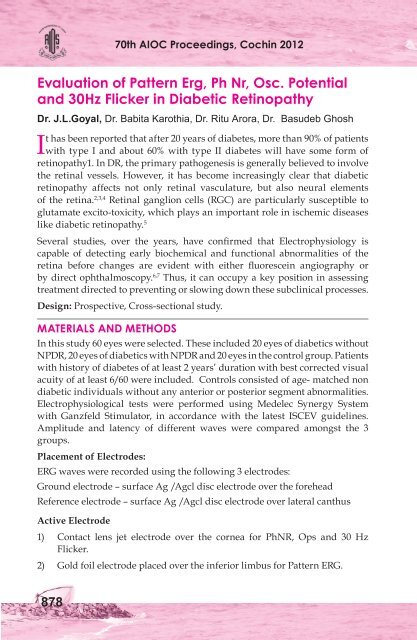Diabetic Retinopathy & Medical Retina - aioseducation
Diabetic Retinopathy & Medical Retina - aioseducation
Diabetic Retinopathy & Medical Retina - aioseducation
You also want an ePaper? Increase the reach of your titles
YUMPU automatically turns print PDFs into web optimized ePapers that Google loves.
70th AIOC Proceedings, Cochin 2012<br />
Evaluation of Pattern Erg, Ph Nr, Osc. Potential<br />
and 30Hz Flicker in <strong>Diabetic</strong> <strong>Retinopathy</strong><br />
Dr. J.L.Goyal, Dr. Babita Karothia, Dr. Ritu Arora, Dr. Basudeb Ghosh<br />
It has been reported that after 20 years of diabetes, more than 90% of patients<br />
with type I and about 60% with type II diabetes will have some form of<br />
retinopathy1. In DR, the primary pathogenesis is generally believed to involve<br />
the retinal vessels. However, it has become increasingly clear that diabetic<br />
retinopathy affects not only retinal vasculature, but also neural elements<br />
of the retina. 2,3,4 <strong>Retina</strong>l ganglion cells (RGC) are particularly susceptible to<br />
glutamate excito-toxicity, which plays an important role in ischemic diseases<br />
like diabetic retinopathy. 5<br />
Several studies, over the years, have confirmed that Electrophysiology is<br />
capable of detecting early biochemical and functional abnormalities of the<br />
retina before changes are evident with either fluorescein angiography or<br />
by direct ophthalmoscopy. 6,7 Thus, it can occupy a key position in assessing<br />
treatment directed to preventing or slowing down these subclinical processes.<br />
Design: Prospective, Cross-sectional study.<br />
MATERIALS AND METHODS<br />
In this study 60 eyes were selected. These included 20 eyes of diabetics without<br />
NPDR, 20 eyes of diabetics with NPDR and 20 eyes in the control group. Patients<br />
with history of diabetes of at least 2 years’ duration with best corrected visual<br />
acuity of at least 6/60 were included. Controls consisted of age- matched non<br />
diabetic individuals without any anterior or posterior segment abnormalities.<br />
Electrophysiological tests were performed using Medelec Synergy System<br />
with Ganzfeld Stimulator, in accordance with the latest ISCEV guidelines.<br />
Amplitude and latency of different waves were compared amongst the 3<br />
groups.<br />
Placement of Electrodes:<br />
ERG waves were recorded using the following 3 electrodes:<br />
Ground electrode – surface Ag /Agcl disc electrode over the forehead<br />
Reference electrode – surface Ag /Agcl disc electrode over lateral canthus<br />
Active Electrode<br />
1) Contact lens jet electrode over the cornea for PhNR, Ops and 30 Hz<br />
Flicker.<br />
2) Gold foil electrode placed over the inferior limbus for Pattern ERG.<br />
878

















